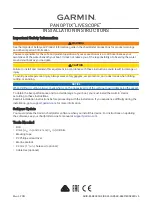
Product Manual for IonPac CS16
Page 45 of 65
5.20.
Gradient Elution of Ethanolamine, Hydrazine, and the Common Cations
Ethanolamine and hydrazine are common additives in Power Plant waters and these together with ammonium, sodium and
the other cations need to be carefully monitored. The CS16 3-mm uses lower eluent flow rate than the CS16 5-mm and
therefore is better suited for process applications. Ratios of 20,000:1 of sodium to ammonium can be separated on the CS16
3-mm using a MSA gradient.
Column:
IonPac CS16 3-mm Analytical Column
Sample Volume:
25 µL Loop
Eluent:
7 mM MSA, gradient to 52 mM MSA from 23 to
28 min, step to 7 mM MSA at 35 min.
Eluent Source:
EG40
Eluent Flow Rate:
0.43 mL/min
Temperature: 40
°C
SRS Suppressor:
Cation Self-Regenerating Suppressor 300 (2-mm)
in AutoSuppression Recycle Mode
CTC-1 (P/N 043132) between CELL OUT and REGEN IN ports
or MMS Suppressor:
Cation MicroMembrane Suppressor, CMMS 300 (2-mm)
MMS Regenerant:
TBAOH
MMS Mode:
Displacement Chemical Regeneration (DCR)
Expected Background Conductivity:
< 2 µS
Storage Solution:
Eluent
0
5
10
15
20
25
30
35
40
0
0.88
1.75
2.63
3.50
µS
1
2
3
4
5
6
7
8
Analyte mg/L
1. Lithium
0.1
2. Sodium
0.4
3. Ammonium
0.5
4. Ethanolamine
1.0
5. Hydrazine
4.0
6. Potassium
1.0
7. Magnesium
0.5
8. Calcium
1.0
Minutes
0
5
10
15
20
25
30
35
0
0.88
1.75
2.63
3.50
µS
2
3
4
5
6
7
8
Analyte µg/L
1. Lithium
2500
2. Sodium
6
3. Ammonium
100
4. Ethanolamine
2000
5. Hydrazine
4000
6. Potassium
4
7. Magnesium
1
8. Calcium
6
Minutes
Figure 29
Gradient Elution of Ethanolamine, Hydrazine, and the Common Cations
Document No. 031747-05
© 2010 Dionex Corporation
December 2010
















































